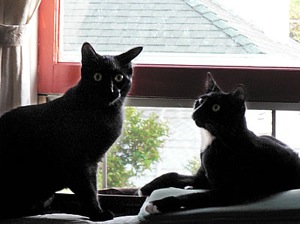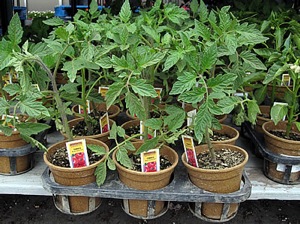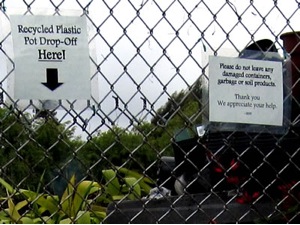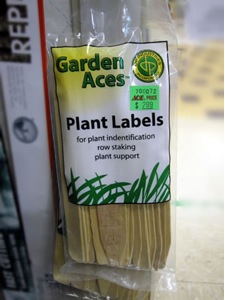By guest blogger Beth Terry. For Part 1.
A few weeks ago, I began my plastic-free gardening project in my tiny Oakland, CA, yard with the help of Rodale.com and Eric Hurlock, of OrganicGardening.com. I built a raised bed with sustainable wood, and filled it with bulk gardening soil that I had delivered without any packaging. So far, so good. But buying plants and watering them has proven to be a little trickier, plastic-ally speaking.
(Why plastic-free gardening? See my blog, MyPlasticfreeLife.com to understand the problems with plastic and get tips for how to live with as little of it as possible.)
Planting Seeds
I bought Botanical Interests–certified organic seeds, which come in paper envelopes and are readily available at garden centers where I live. I have: Swiss chard, spinach, baby carrots, wax beans, cucumbers, marigolds, and nasturtium.
Ideally, I would have started some of my seeds indoors, but I could not find a single sunny spot in my house that would not be accessible to the Furry Ones Who Reign Supreme and thus vulnerable to their propensity for Total Destruction.
If I had been able to start seeds inside, I would have done it plastic free. Browsing the gardening aisle at my local Ace Hardware store, I found Plantation Products starter pots made from recycled natural fiber in plastic-free packaging.
Browsing the Web, I found a few better ideas. Rodale.com’s Jean Nick gives instructions for making seed-starting pots from newspaper. And blogger Mrs. Green of MyZeroWaste.com creates starter pots from used cardboard toilet paper tubes. Here’s her handy video demonstration:
Knowing that starting seeds indoors would be futile, I planted my seeds directly in the ground, which, it turns out, has its own challenges. More on that shortly…
No Plastic Pots
Eric had suggested I plant my tomatoes and peppers from seedlings rather than seeds. So the challenge for me was to avoid buying plants in plastic pots.
Fortunately, most of the garden centers in my area are supplied by a company in Sebastopol called Sweetwater Nursery, which offers plants in compostable Ecoform containers made from compressed rice hulls. I bought tomatoes, peppers, yellow squash, zucchini, cucumber, and some herbs in these containers.
Note: Ecoform pots are brittle, and crack easily if you squeeze them the way you would plastic pots when removing the plants. But I found that if I carefully loosened the dirt around the edges with a trowel, I could take out the plant and spare the pot to reuse it. Sure, the pots are compostable. But why not reuse them as much as possible before returning them to the earth?
If you can’t find plants in plastic-free pots, check with your garden center or nursery and see if they will take back the plastic pots to reuse. In addition to the plants from Sweetwater Nursery, I bought some herbs from a local vendor at my farmer’s market. Knowing her plants are sold in plastic containers, I brought some of my own pots (the empty Ecoform pots I’d saved) with me and asked her if I could transfer the plants into my own containers. She was more than happy to have her plastic pots back.
What’s more, I learned that the Berkeley Horticultural Nursery has set aside a spot for customers to return their plastic containers. According to an employee I spoke with, the pots are returned to the growers for reuse.
So what about recycling? It’s true that some communities allow all plastics, including plant containers, in their recycling bins. But the fact is, a lot of the plastic we toss into the bin might not actually get recycled. And the stuff that does is in fact downcycled. Read my post on the problems with recycling to understand why it should be the last option for dealing with plastic waste, not the first.
Oh, Those Darned Plastic Plant Markers
One thing I haven’t been able to avoid is the plastic markers that come with new plants. I contacted Sweetwater Nursery to find out if I could send them back to reuse. No luck. Janis from Sweetwater said that the company has been trying for years to find a plastic-free alternative, but so far has not come up with anything better than the plastic ones. And they won’t take them back. So I guess the plant markers are my first plastic failure in this little experiment. Next year, I’ll either start all my plants from seeds or see if I can find local gardeners with plants to sell or give away.
As for marking my seeds, several readers have recommended wooden Popsicle sticks, which would be great if I had a bunch of used popsicle sticks lying around. But I don’t, and new wooden plant markers come packaged in a plastic bag.
So I’m using the backs of some plastic markers I already had from previous years. I wrote on them with pencil so I can reuse them. (Sadly, the Sweetwater markers are printed on both the front and back, so I can’t reuse those markers in this way.)
Avoid Plastic-Coated Plant Cages
In her Rodale.com article, “Keep Your Garden Plastic Free with These Easy Swaps,” Jean Nick’s first bit of advice is to “kick coated products to the curb.” She means vinyl-coated wire products, like the stuff some plant cages are made from. Sadly, my tomato and pepper cages are coated with dark green plastic. But I’m not counting them as a plastic failure this year, because these are cages I bought several years ago during my very first tomato-growing attempt. I figure it’s better to use what I already have than to buy new. So, along with the plant markers, the cages are another plastic item in my garden.
Mulching
Don’t laugh, but I honestly didn’t know what mulch did or what it was for before speaking with Eric. According to Organic Gardening magazine:
Mulch prevents weeds from sprouting up in your garden, keeps soil moist and aerated, protects your plants from soilborne diseases, replenishes the soil as it decomposes, and keeps your yard and garden looking well tended. But which mulch is best for your needs?
Mulch can be grass clippings, leaves, pine needles, or other organic matter. Eric recommended straw, so after calling around, I took a Zip Car pickup truck to The Urban Farmer Store in Richmond, CA, to buy a bale of straw.
I now have enough straw to cover the moon. So if you live in the Oakland/Berkeley area and want some straw, let me know. I have way more than I need for mulching. I think. What I didn’t realize when buying the straw was that it’s tied together with plastic twine. So this is plastic failure #2. Still, a little twine is a lot less plastic than I’d end up with if I bought plastic bags of mulch or even plastic mulch. And grass clippings, leaves, and pine needles were not readily available in my urban neighborhood.
Want to see what else Maria is up to? Sign up today to receive Maria’s Farm Country Kitchen Second Helping newsletter delivered free to your inbox every Wednesday starting the week of July 11.
To celebrate, we’re hosting a giveaway-a-day until the unveiling of her newsletter on July 11! Enter for a chance to win Maria’s Get Set to Garden kit, which includes a copy of Tart and Sweet and nine 5 inch straw planting pots. Email as described below before July 6, 2011.
1. Email rodalecontests@rodale.com with Maria’s Farm Country Kitchen Get Set to Garden Sweepstakes in the subject line. Include your first and last name, complete home mailing address, daytime telephone number and date of birth.
Minimal Disclosure: No purchase necessary to enter or win. A purchase will not improve your chances of winning. Void where prohibited. Maria’s Farm Country Kitchen Get Set to Garden begins at 7:30am EST on July 5, 2011 and ends at 11:59 pm EST on July 5, 2011. Must be 18 and legal resident of 50 United States or DC. For Official Rules, go here. Rodale Inc., 400 South 10th St., Emmaus, PA 18098 is the operator of the sweepstakes.








Great tips, Beth. I love the start pots made from toilet paper rolls. We have plenty of those in our home!
we have found that starting seeds on the top rack of the bakers rack – with a well placed cactus keeps the seeds safe from the furry ones…
I work at a nursery, and although we do tag everything with a plastic label for customers, I also write on the pots of many plants. We do that because sometimes labels get lost, and also to document when a particular plant went into the pot, along with various other growing information. I use either china markers, aka fancy crayons, or old-fashioned pencil. Of course, I’m writing on plastic pots or wooden tree boxes, but crayons or pencil might work for you on some of the pots that you are using. Something else I’ve used at the nursery, because we grow bamboo, are bamboo sticks cut to size. I use china markers on these. They have a nice smooth, albeit rounded, surface that is easy to write on. At home, I use a lot of terracotta pots and wooden flats and I use a crayon or dark pencil to label the pots and flats that the various plants are growing in. To remove the label for resuse, just sand the wax or graphite off.
Thank Martha Stewart for this one: take a few fresh twigs and slice off a flat side with your vegetable peeler. Now you have a surface to write on. They’re beautifully natural, abundant, and perfect!
nemusser, brilliant! I would never thought of guarding my seeds with cactuses. Will try it. Hoping kitties don’t have to learn the hard way, though.
beth – your furries look smart – and believe me – it just takes once – our cactus’s all have long needles on them – I think that is better – some smaller needled ones – it is hard to get the out if you have to – I use my kitchen tongs – or grilling tongs to transplant the things – I learned too 🙂